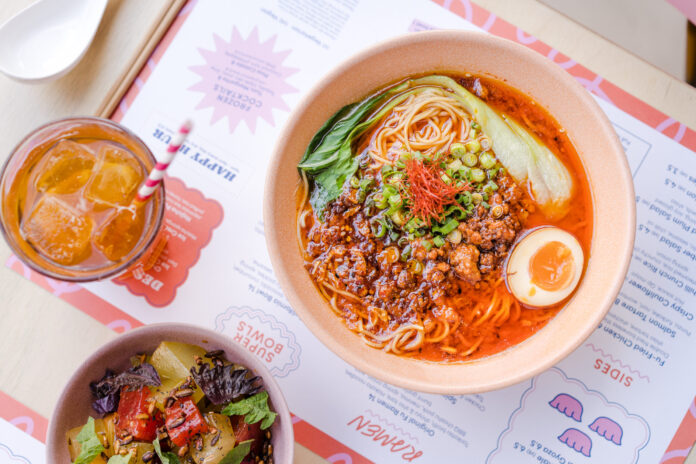When we think of certain habits being quintessentially ‘British’, there are a few topics that show up by default — cricket, tea-drinking, and moaning about the weather to name but a few. But there have been some troublesome murmurs through media outlets in recent years that something terrible could be afoot for Britishness as a concept. Nope, not Brexit. It seems that in this world gone mad, British people are allegedly drinking less tea than we used to.
Fortunately, despite being in a perpetual state of crisis, it turns out that Britain is not currently in the throes of a tea-based national emergency. While research shows traditional tea consumption was down by 870 million cups in 2017, the value of tea rose 0.6%. The market is far from floundering; especially with products such as fair trade tea becoming more readily available. Indeed, it’s the self-care side of things that seems to be keeping your teabag afloat. With that in mind, here’s our guide to the IDEAL health and wellness benefits of tea.
WHAT TEA-DRINKER ARE YOU?
Tea drinkers are everywhere, enjoying every sip of tea because of its health and wellness benefits. But, what type of tea-drinker are you?
According to a Modern Tea Trends 2019 study, 50 per cent of tea brands identified the 24–35 year old group as their biggest growing demographic. Perhaps because of this, the view (and marketing) of tea has changed. It’s no longer a milky, warm beverage that sits on a table while people discuss problems, though it is still the go-to makeshift remedy for everything from a bad day at work to a broken leg.
National Tea Day recognises two main groups of tea-drinkers. Ready for a quick quiz to find out which type you are?

Is it more important to you for your tea to be comforting or healthy?
- Comforting. If a good strong brew can’t fix it, it’s probably not worth fixing.
- Healthy. A good tea should give me energy, pep, and cleanse my inner being.
Your perfect cup of tea would be…
- Creamy or milky. Best described as a ‘hug in a mug’.
- Colourful. Whether it’s red, blue, green, or purple, it needs to be bright and beautiful.
Sensory-wise, you expect your tea experience to be…
- Sweet, or sweet-ish. If you wanted to assault your tongue with bitter tones, you’d have ordered a coffee…
- Sensual, or aromatic. The experience of my tea is not just in taste but in smell. It should pamper my nose as much as my tongue.
If you answered mainly a… you are a Traditionalist. You care about your tea being a healing drink, but not necessarily in the sense of it carrying antioxidants or being hydrating. It’s just about comfort for you, a means to relax and calm down with a soothing cup of milky tea.
If you answered mainly b… you are a Modernist. Times are changing, and so is your go-to tea. Your tea isn’t always designed to make you fall into a milk-and-sugar-wrapped blanket of cosy warmth. Sure, camomile tea will relax you when you need it, but you have tea for every occasion. For energy, for a cold, for digestion, for preserving health, for anxiety, you name it, you’ve got a type of tea to wind around all the senses and sort it right out.
To make the most of your tea experiences, you may want to try a wide range of cold infusion tea. Many tea manufacturers and suppliers can provide you with the teas you need to transform your water beverage into something more refreshing with an authentic flavour of fresh leaf tea.
TEA IS EVOLVING
Tea has certainly become much more of an experience than just a go-to beverage. This ties in with the rise of herbal teas over standard black leaf tea — herbal teas come in so many varieties, from all over the world, and often have intricate ceremonies or stories attached to them. These aspects are as much of the ‘sensual’ experience as the tea itself.
Cafés and tea rooms have been using this to their benefit too, offering tea experiences for their customers, such as offering food created to complement the flavour of different herbal teas, or brewing the leaves in a beautiful antique silver teapot in order to achieve a higher brewing temperature than a normal teapot, and making use of silver’s neutrality, protecting the pure taste of the tea. The whole experience is catered for the customer’s enjoyment.
TWO MAJOR TYPES OF TEAS
Tea can be conventional or organic. Conventional teas were grown using fertiliser, fungicides, herbicides, or pesticides to protect crops from unwanted pests. On the other hand, organic teas are free from these agents. So, many people prefer organic teas, like Creta tea from Tofillo and other trusted tea companies.
Majority of the world’s supply of teas comes from poor communities with poor regulatory standards. Hence, farmers lack education about the ill effects of pesticides on health. So, if you want to attain ideal health and wellness, choosing organic tea over conventional tea is highly recommended.
Organic teas are produced using sustainable farming practices. Farmers don’t use chemicals, so end users like you won’t face any health issues arising from chemical fertilisers. Organic tea tastes a lot better, too, than conventional tea, allowing you to enjoy an ultimately great tea experience.
THE RAINBOW OF TEA VARIETIES
Not only are our drinking habits shape shifting. Now, the popularity of a full rainbow spectrum of tea colours and flavours is rising, too. Here’s just a few of them…
Red is for…hibiscus tea
Calorie and caffeine-free on its own, this bright red beverage is certainly pleasing to the eye. It has a sweet and tart taste and is popular in North Africa and Southeast Asia. Particularly in Africa, hibiscus tea is touted as having many benefits, including helping with a sore throat and high blood pressure. Indeed, one study has noted that hibiscus tea contributed to the reduction of the systolic blood pressure of its participants.
Orange is for…barley tea
Barley tea is a popular brew over in China, and Japan, and it is also tied to many claims of health benefits. Served hot or cold depending on the season, this go-to Korean drink is made from whole grain roasted barley and has a mild nutty taste. Like hibiscus tea, it’s caffeine-free.
There are a lot of health claims tied to barley tea, but only a few have been proven by scientific study. These range from claims to help with cold symptoms, aiding a sore stomach, clearing complexion, and even weight loss. But, if nothing else, it’s a great caffeine-free alternative to coffee and traditional tea!
Yellow is for…lemon and honey tea
The beloved remedy of many cold and flu sufferers, lemon and honey tea is uniquely soothing. This golden-coloured tea boasts cold symptom fighting capabilities but it’s also been said to help with everything from weight loss to acne.
With the vitamin C boost from the lemon, and the cough-supressing nature of the honey, this is a drink that’s not to be sniffed at. Indeed, you won’t be sniffing; it does actually have some scientific backing in terms of helping with a cough and general sniffles. But sadly the claims of clearing acne and weight loss are as yet unconfirmed by scientific study. Still, it is definitely one to reach for next time cold season comes around.
Green is for…green tea
It would probably make for a shorter list to say what health benefit green tea hasn’t been attributed to. You’d be forgiven for thinking green tea was brewed from the Fountain of Youth, for all the attention it has gained in the wellness industry. But are any of the stories true?
Luckily, the answer is yes. Green tea is packed with antioxidants and catechins, the latter of which could slow down bacterial growth. The green brew has also been claimed to reduce the risk of cardiovascular disease and boost metabolic rate.
Moreover, green tea’s antioxidant properties may also help counteract oxidative stress on the brain that is potentially linked to neurological disorders like Alzheimer’s and Parkinson’s disease.
Blue is for…butterfly pea flower tea
Now, here’s one for Instagram. This blue brew changes colour depending on the pH level of ingredients added to it — for example, a little lemon will turn it purple! Butterfly pea flower tea sounds fancy, looks fancy, but does it bring anything fancy to the table in terms of health benefits?
The sapphire-hued drink has been used for centuries in Asia, but it’s only started fluttering into the western world of tea in recent years. The tea, like green tea, carries a lot of antioxidants and has been tied to claims of protecting the skin. There are studies that support butterfly pea flower tea’s ability to help reduce internal inflammation.
Indigo is for…blackcurrant tea
No, this doesn’t mean making Ribena with hot water, though that is a tasty drink in its own right. Herbal blackcurrant tea doesn’t always brew with a purple hue, strictly speaking. But the purple berries that make this tea bring some great potential benefits to your tea cup, such as a high vitamin C level, antibacterial properties, and reducing inflammation.
Violet is for…purple tea
This violet-shaded drink has a very humble name in ‘purple tea’. But its alternative name, ‘ox-blood’, sounds much more ferocious. It is claimed that purple tea could compete with green tea for the crown of most purported health benefits, such as claims to help protect against cardiovascular diseases and there are even stories of it improving vision.
OTHER TYPES OF TEA
Apart from the full rainbow spectrum of tea colours and flavours mentioned above, other tea types have excellent health and wellness benefits. These include the following:
White is for…white tea
White tea is made from the Camellia sinensis plant, native to India and China. Although it’s the least processed variety of tea, white tea is said to have a benefit in fighting several forms of cancer. Since it also contains high levels of fluoride, tannins, and catechins, it may help protect your teeth from potential damage and other dental problems.
Moreover, white tea contains the least amount of caffeine, which is suitable for tea drinkers trying to minimise caffeine consumption.
Black is for…black tea
Black tea is made from fermented tea leaves. It contains the highest content of caffeine. Nevertheless, some studies claim that black tea may help protect the lungs from the damage caused by excessive cigarette smoke. It also helps reduce the potential risk of stroke and other related diseases.
You may have noticed from the above that many herbal teas come with a whole host of claims to help health-wise. But if nothing else, tea does count towards your daily water needs, with the dehydrating claims of tea having been debunked. So, top up that tea cup — it’s trendy and healthy!





